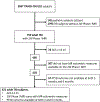Smaller Regional Brain Volumes Predict Posttraumatic Stress Disorder at 3 Months After Mild Traumatic Brain Injury
- PMID: 33386283
- PMCID: PMC7946719
- DOI: 10.1016/j.bpsc.2020.10.008
Smaller Regional Brain Volumes Predict Posttraumatic Stress Disorder at 3 Months After Mild Traumatic Brain Injury
Abstract
Background: Brain volumes in regions such as the hippocampus and amygdala have been associated with risk for the development of posttraumatic stress disorder (PTSD). The objective of this study was to determine whether a set of regional brain volumes, measured by magnetic resonance imaging at 2 weeks following mild traumatic brain injury, were predictive of PTSD at 3 and 6 months after injury.
Methods: Using data from TRACK-TBI (Transforming Research and Clinical Knowledge in TBI), we included patients (N = 421) with Glasgow Coma Scale scores 13-15 assessed after evaluation in the emergency department and at 2 weeks, 3 months, and 6 months after injury. Probable PTSD diagnosis (PTSD Checklist for DSM-5 score, ≥33) was the outcome. FreeSurfer 6.0 was used to perform volumetric analysis of three-dimensional T1-weighted magnetic resonance images at 3T obtained 2 weeks post injury. Brain regions selected a priori for volumetric analyses were insula, hippocampus, amygdala, superior frontal cortex, rostral and caudal anterior cingulate, and lateral and medial orbitofrontal cortices.
Results: Overall, 77 (18.3%) and 70 (16.6%) patients had probable PTSD at 3 and 6 months. A composite volume derived as the first principal component incorporating 73.8% of the variance in insula, superior frontal cortex, and rostral and caudal cingulate contributed to the prediction of 3-month (but not 6-month) PTSD in multivariable models incorporating other established risk factors.
Conclusions: Results, while needing replication, provide support for a brain reserve hypothesis of PTSD and proof of principle for how prediction of at-risk individuals might be accomplished to enhance prognostic accuracy and enrich clinical prevention trials for individuals at the highest risk of PTSD following mild traumatic brain injury.
Keywords: Amygdala; Brain; Cingulate; Insula; PTSD; Posttraumatic stress disorder; TBI; Traumatic brain injury.
Published by Elsevier Inc.
References
-
- Kunimatsu A, Yasaka K, Akai H, Kunimatsu N, Abe O (2019): MRI findings in posttraumatic stress disorder. J Magn Reson Imaging. - PubMed
Publication types
MeSH terms
Grants and funding
LinkOut - more resources
Full Text Sources
Other Literature Sources
Medical


